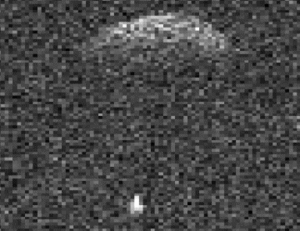
|
| ©Arecibo |
"We're also getting images from NASA's Goldstone radar in the Mojave desert of California," he adds. That radar is smaller than Arecibo but it is still registering a strong echo that should reveal much about the target, including the binary orbit, masses and bulk density of the components.
About 16% of all near-Earth asteroids are binaries, but only a handful have come this close. "2008 BT18 is giving us a good look at a double asteroid," says Benner. Studying the make-up and dynamics of these systems may help researchers figure out how to deflect binaries on a collision course with Earth. 2008 BT18 poses no threat, but some undiscovered binary asteroid, one day, might. "The Arecibo observatory, where 53% of all near-Earth binaries have been discovered, is crucial to these studies."
Southern hemisphere readers, you may be able to observe this double-rock using your own backyard telescope and CCD camera. At closest approach (1.4 million miles) on July 14th, 2008 BT18 will flit through Canis Major heading south and glowing like a 13th magnitude star: ephemeris, 3D orbit.



Reader Comments
to our Newsletter